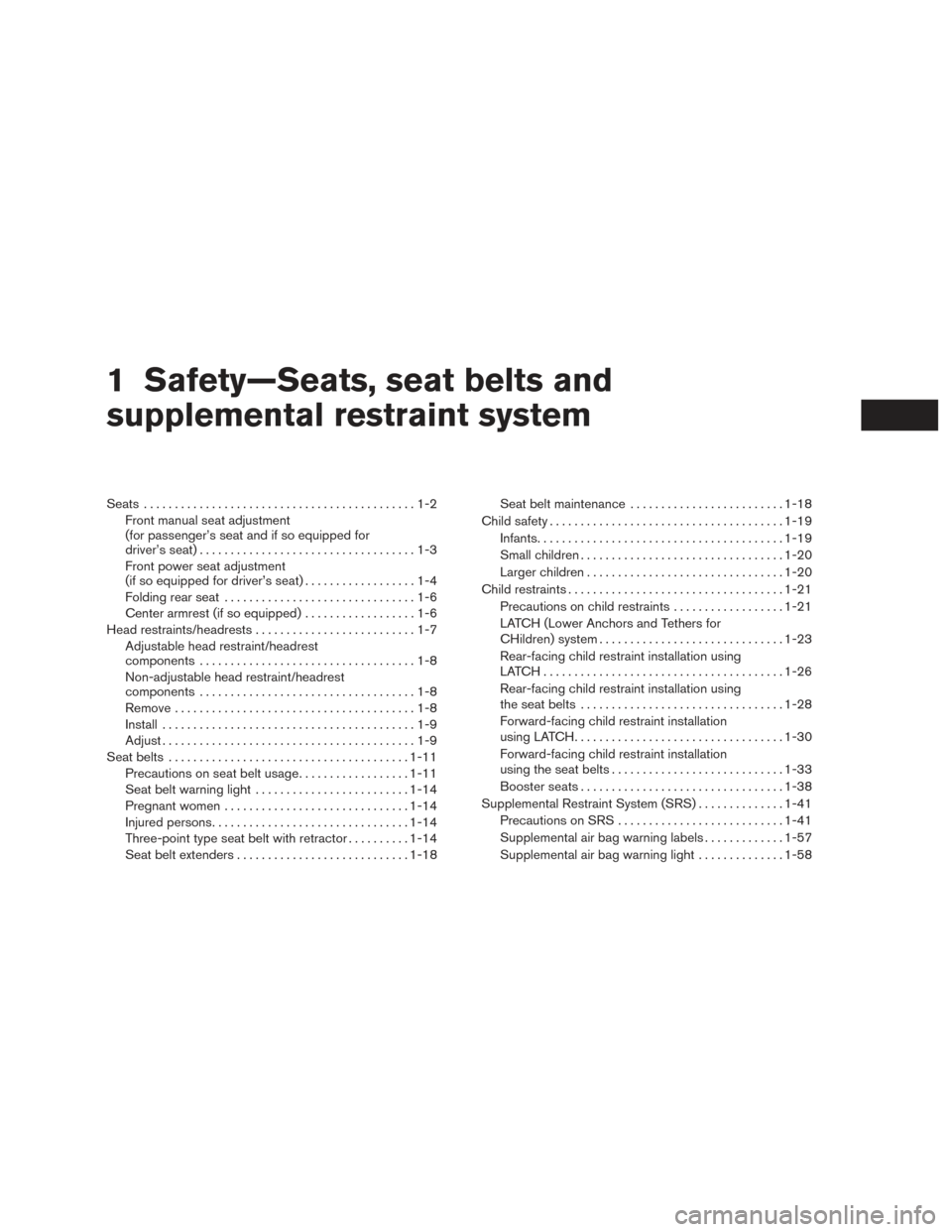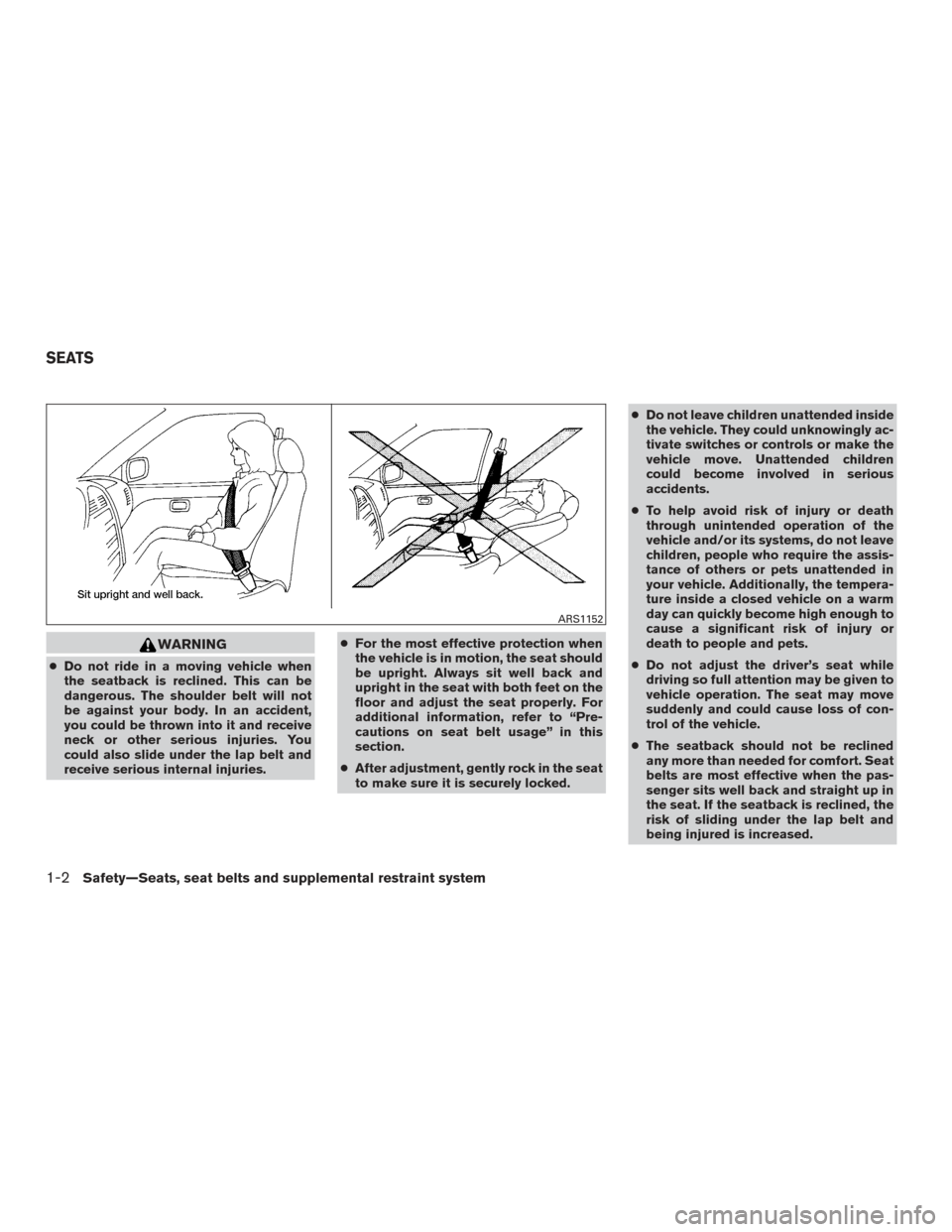Page 6 of 491
Table of
ContentsIllustrated table of contents
Safety—Seats, seat belts and supplemental restraint system
Instruments and controls
Pre-driving checks and adjustments
Monitor, climate, audio, phone and voice recognition systems
Starting and driving
In case of emergency
Appearance and care
Do-it-yourself
Maintenance and schedules
Technical and consumer information
Index
0
1
2
3
4
5
6
7
8
9
10
11
Page 9 of 491
1. Top tether anchors (P. 1-21)
2. Rear seat belts (P. 1-11)
3. Roof-mounted curtain side-impact andsupplemental rollover air bag (P. 1-41)
4. Head restraints/headrests (P. 1-7)
5. Front seat belt with pretensioner(s) and
shoulder height adjuster (P. 1-11, 1-41)
6. Supplemental front-impact air bags
(P. 1-41)
7. Front seats (P. 1-2)
8. Occupant classification sensor (weight
sensor) (P. 1-41)
9. Front seat-mounted side-impact
supplemental air bag (P. 1-41)
10. Rear seats (P. 1-2)
11. LATCH (Lower Anchors and Tethers for
CHildren) system (P. 1-21)
Refer to the page number indicated in pa-
rentheses for operating details.
LII2403
AIR BAGS, SEAT BELTS AND CHILD
RESTRAINTS
0-2Illustrated table of contents
Page 20 of 491

1 Safety—Seats, seat belts and
supplemental restraint system
Seats............................................1-2
Front manual seat adjustment
(for passenger’s seat and if so equipped for
driver’s seat) ...................................1-3
Front power seat adjustment
(if so equipped for driver’s seat) ..................1-4
Folding rear seat ...............................1-6
Center armrest (if so equipped) ..................1-6
Head restraints/headrests ..........................1-7
Adjustable head restraint/headrest
components ...................................1-8
Non-adjustable head restraint/headrest
components ...................................1-8
Remove .......................................1-8
Install .........................................1-9
Adjust .........................................1-9
Seat belts ....................................... 1-11
Precautions on seat belt usage ..................1-11
Seat belt warning light ......................... 1-14
Pregnant women .............................. 1-14
Injured persons ................................ 1-14
Three-point type seat belt with retractor ..........1-14
Seat belt extenders ............................ 1-18Seat belt maintenance
......................... 1-18
Child safety ...................................... 1-19
Infants ........................................ 1-19
Small children ................................. 1-20
Larger children ................................ 1-20
Child restraints ................................... 1-21
Precautions on child restraints ..................1-21
LATCH (Lower Anchors and Tethers for
CHildren) system .............................. 1-23
Rear-facing child restraint installation using
LATCH....................................... 1-26
Rear-facing child restraint installation using
the seat belts ................................. 1-28
Forward-facing child restraint installation
using LATCH .................................. 1-30
Forward-facing child restraint installation
using the seat belts ............................ 1-33
Booster seats ................................. 1-38
Supplemental Restraint System (SRS) ..............1-41
Precautions on SRS ........................... 1-41
Supplemental air bag warning labels .............1-57
Supplemental air bag warning light ..............1-58
Page 21 of 491

WARNING
●Do not ride in a moving vehicle when
the seatback is reclined. This can be
dangerous. The shoulder belt will not
be against your body. In an accident,
you could be thrown into it and receive
neck or other serious injuries. You
could also slide under the lap belt and
receive serious internal injuries. ●
For the most effective protection when
the vehicle is in motion, the seat should
be upright. Always sit well back and
upright in the seat with both feet on the
floor and adjust the seat properly. For
additional information, refer to “Pre-
cautions on seat belt usage” in this
section.
● After adjustment, gently rock in the seat
to make sure it is securely locked. ●
Do not leave children unattended inside
the vehicle. They could unknowingly ac-
tivate switches or controls or make the
vehicle move. Unattended children
could become involved in serious
accidents.
● To help avoid risk of injury or death
through unintended operation of the
vehicle and/or its systems, do not leave
children, people who require the assis-
tance of others or pets unattended in
your vehicle. Additionally, the tempera-
ture inside a closed vehicle on a warm
day can quickly become high enough to
cause a significant risk of injury or
death to people and pets.
● Do not adjust the driver’s seat while
driving so full attention may be given to
vehicle operation. The seat may move
suddenly and could cause loss of con-
trol of the vehicle.
● The seatback should not be reclined
any more than needed for comfort. Seat
belts are most effective when the pas-
senger sits well back and straight up in
the seat. If the seatback is reclined, the
risk of sliding under the lap belt and
being injured is increased.
ARS1152
SEATS
1-2Safety—Seats, seat belts and supplemental restraint system
Page 22 of 491

CAUTION
When adjusting the seat positions, be
sure not to contact any moving parts to
avoid possible injuries and/or damage.
FRONT MANUAL SEAT
ADJUSTMENT (for passenger’s seat
and if so equipped for driver’s seat)
Your vehicle seats can be adjusted manually. For
additional information about adjusting the seats,
refer to the steps outlined in this section.
Forward and backward
Pull the center of the bar up and hold it while you
slide the seat forward or backward to the desired
position. Release the bar to lock the seat in
position.
Reclining
To recline the seatback, pull the lever up and lean
back. To bring the seatback forward, pull the lever
up and lean your body forward. Release the lever
to lock the seatback in position.
The reclining feature allows adjustment of the
seatback for occupants of different sizes for
added comfort and to help obtain proper seat
belt fit. For additional information, refer to “Pre-
cautions on seat belt usage” in this section. Also,
the seatback can be reclined to allow occupants
to rest when the vehicle is stopped and the shift
lever (CVT) is in P (Park) or the manual shift lever
is in N (Neutral) with the parking brake applied.
LRS2642LRS2643
Safety—Seats, seat belts and supplemental restraint system1-3
Page 23 of 491
Seat lifter (driver’s seat)
Move the adjusting lever as shown to adjust the
seat height until the desired position is achieved.
FRONT POWER SEAT ADJUSTMENT
(if so equipped for driver’s seat)
Operating tips
●The power seat motor has an auto-reset
overload protection circuit. If the motor
stops during operation, wait 30 seconds
then reactivate the switch. ●
Do not operate the power seat switch for a
long period of time when the engine is off.
This will discharge the battery.Forward and backward
Moving the switch as shown will slide the seat
forward or backward to the desired position.
Reclining
Move the recline switch as shown until the de-
sired angle is obtained.
The reclining feature allows adjustment of the
seatback for occupants of different sizes for
added comfort and to help obtain proper seat
LRS2644LRS2662
1-4Safety—Seats, seat belts and supplemental restraint system
Page 24 of 491
belt fit. For additional information, refer to “Pre-
cautions on seat belt usage” in this section. Also,
the seatback can be reclined to allow occupants
to rest when the vehicle is stopped and the shift
lever is in P (Park) or N (Neutral) position with the
parking brake fully applied.
Seat lifter
Move the switch as shown to adjust the height of
the seat cushion.
Lumbar support
The lumbar support feature provides adjustable
lower back support to the driver. Push the switch
as shown to adjust the seatback lumbar area.
LRS2784LRS2745
Safety—Seats, seat belts and supplemental restraint system1-5
Page 25 of 491

FOLDING REAR SEAT
Pull the knob�Ato fold each seatback down.
WARNING
●Never allow anyone to ride in the cargo
area or on the rear seat when it is in the
fold-down position. Use of these areas
by passengers without proper restraints
could result in serious injury or death in
an accident or sudden stop. ●
Properly secure all cargo with ropes or
straps to help prevent it from sliding or
shifting. Do not place cargo higher than
the seatbacks. In a sudden stop or col-
lision, unsecured cargo could cause
personal injury.
● When returning the seatbacks to the
upright position, be certain they are
completely secured in the latched posi-
tion. If they are not completely secured,
passengers may be injured in an acci-
dent or sudden stop.
● Closely supervise children when they
are around cars to prevent them from
playing and becoming locked in the
trunk where they could be seriously in-
jured. Keep the car locked, with the rear
seatback and trunk lid securely latched
when not in use, and prevent children’s
access to car keys.
CENTER ARMREST (if so equipped)
Pull the armrest down until in resting position.
LRS2194LRS2217
1-6Safety—Seats, seat belts and supplemental restraint system